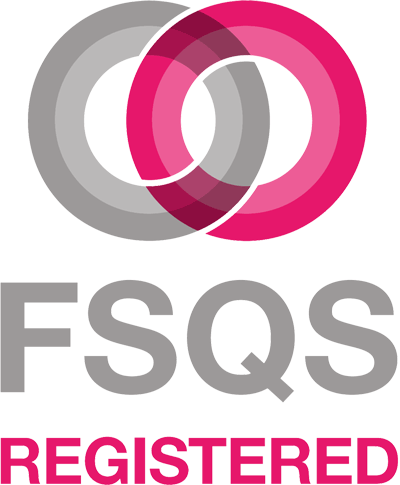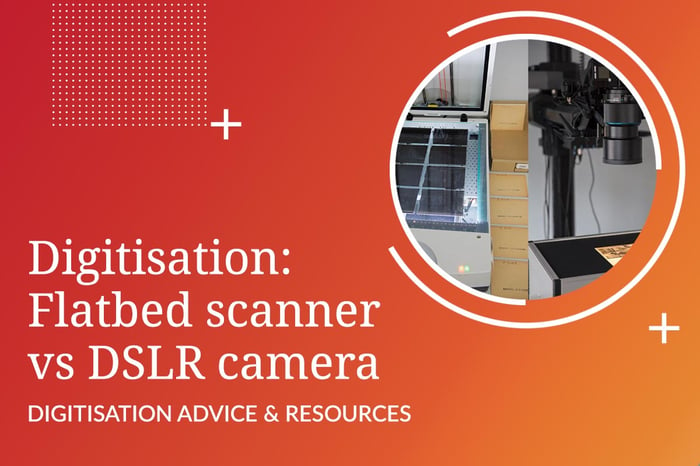
Back in 2015 we wrote our how to digitise glass plate negatives guide, offering advice and best practice tips for digitisation. We also made reference to the two main workflows for digitising glass plates:
So how should I plan for digitisation? We hear you ask. Well, both approaches have their own merits and limitations, so we thought it best to invite two experts along to tell you a bit more about their own digitisation process and workflows. We have great pleasure in welcoming Ted Dearberg of the Imperial War Museum London and Andrew Bruce of The Postal Museum, who have taken the time to contribute their personal views on a given method, the workflows that they use to digitise glass plate negatives, and why this has proved the best approach for achieving their institution’s unique goals.
Firstly Ted Dearberg tells us a bit about his role within the Imperial War Museum London and the workflow that works best for their digitisation needs.
Using a Flatbed scanner - digitisation workflow: Ted Dearberg - IWM London
I am the Digitisation Suite Manager within the Visual Resources department at the Imperial War Museum London. My role is to oversee the scanning of the Museum's photographic archive negative and transparencies. I come from a print and traditional digital reprographic background in print advertising and newspapers, and started at the IWM in 2002, when we established our digitisation programme for the photographic collection.
The Imperial War Museum’s Collection
Our collection is made up of both glass plates and negative and transparency film, dating from the First World War through to contemporary conflicts. Although we have some original glass plate negatives, the bulk of the glass plate material that we have digitised so far have been duplicates of film originals that were copied onto glass for preservation purposes.
The Imperial War Museum’s Digitisation Goals
We began digitising in earnest around 2002 and it was very much intended to be for preservation purposes, i.e. to rest the negatives and alleviate the wear and tear that builds up with regular use from traditional photographic printing and duplication. At that time print media, rather than the web, would be the primary output medium for both internal and external clients.
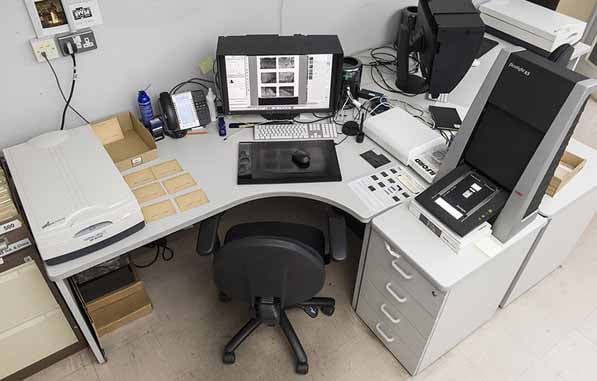
Image above: Digitisation suite at Imperial War Museum London - with the Microtek 1000XL flatbed on the left, Eizo monitor, Mac Pro and Hasselblad Flextight X5 scanner on right.
Our aim when digitising archival photographic material is to create a "one size fits all" digital surrogate that will suit any potential output medium, but using the higher standards required for print reprographics as our benchmark. Given that traditional reprographics already had industry standards for file sizes, bit depths, colour management and file formats we simply adopted (and adapted) those to suit our "one size fits all" philosophy.
It is also important to specify that our collection is a documentary archive. The photographic collection is seen as a collection of images rather than objects. Our focus then, is the high-quality reproduction of the image the negative contains rather than the accurate reproduction of the negative itself.
So, for example, we would not attempt to accurately reproduce the colour casts that emerge from colour negatives and transparencies as they degrade over time. Instead we would allow the digitisation process to remove them giving us a digital file that is much more like the original would have looked when it was taken. This being so, the adoption of traditional print reprographics digitisation methods, which have always been aimed at accurate reproduction and optimisation of images, is a very good fit for our content.
Equipment Necessary for Flatbed Scanning
We carry out our flatbed scanning of glass plates on Microtek Scanmaker 1000XL flatbed scanners using Silverfast scanning software. We chose Silverfast because it can be used on most makes and models of flatbed scanner, so if we change our scanners we don't have to change our software or our workflow, or retrain our operators. Also, it has batch scanning and built in colour management profile creation software.
Image above: Microtek Scanmaker 1000XL scan bed with glass plate negatives laid out for batch scanning
Image above: Screenshot of Silverfast software showing the scan bed ready to scan the batch of glass plate negatives.
The Advantages of Using a Flatbed Scanner
It is perhaps worth pointing out that when we began our digitisation program in 2002, digital cameras were not commercially available and consequently not an option. However, for us, it is the ability to easily colour manage the workflow and ensure accuracy and consistency across input and output that’s the real advantage. Colour management allows us to calibrate the scanners by creating an input profile for the scanner software, which adjusts the Adobe RGB or Grey Gamma 2.2 profiles that we embed in each scan. This is something that can’t be done with a camera.
Photography is essentially the process of controlling the capture of ambient light, whereas scanning is specifically designed for measuring and recording the image content of 2D material. In practice, it’s a subtle distinction. The processes and results seem similar but, for us, it is simply the right tool for the right job, especially as we perform a significant amount of colour negative and transparency digitisation as well. For this, photography is simply not an option.
Over the years we have dabbled with camera capture but it has proved problematic in terms of quality and consistency, particularly for damaged or over or underexposed negatives. Here, the camera accuracy suffers because it compensates by adjusting exposure. Scanners do not do this.
Another advantage for us is that, while a scanning workflow requires expertise to set up, its execution is relatively simple, if you develop a good procedure and it is followed consistently. This has enabled us to engage volunteers in our digitisation projects. Most recently this has seen our Official Second World War Collections Access Scanning project producing between 600 and 1500 low-res scans per day.
Digitisation Workflow and Colour Capture
We capture glass plate negatives in 8bit monochrome, scanning in batches where appropriate. Batch scanning makes it possible for a good operator to run two scanners side-by-side. In doing so we can easily match or exceed a camera based workflow.
The scanner software detects the darkest and lightest points in the image and aligns those with the darkest and lightest tonal values achievable in a digital file, with a little leeway for clipping (black and white points are set to 96% and 4% respectively). We then ensure that a linear curve is applied, which actually means no adjustment to the distribution of tone between those darkest and lightest points in the original.
When the scans are done, we invert the image, and then size and crop the images to 20MB before setting info droppers in the files to mark the highlight and shadow points. This allows operators to keep an eye on them during any subsequent optimisation or digital restoration, to ensure that any correction or retouching does not cause them to clip. It is also a handy thing for the printers receiving the files, for similar reasons.
Capture formats and Resolution
We scan to 20MB for monochrome and 50MB for colour images. Everything is scanned to produce 300ppi images because it is the reprographic standard and the highest resolution needed for any kind of reproduction, in keeping with our "one size fits all" mandate. We use TIFF for scans, master and delivery files; these are our Master Tiff files, from which all delivery files are produced. This equates roughly to A3 in size, but we focus on file sizes in megabytes because this alleviates the need to specify both size and resolution.
We use TIFF for scanning, masters and delivery files. Again, this is based on traditional reprographic practice where TIFF is industry standard. We did use high quality Jpeg for email delivery, but files are usually delivered via FTP these days, negating the need for compression.
Another aspect we deliver is the digital restoration we do to files for our exhibitions. We offer this as a premium service to both internal and external clients. This involves the correction and retouching of images and is such highly skilled work that, in some cases, it can take hours for a single A3 image.
Image above: Example of digitised image before (left) and after (right) being digitally restored by the team at IWM London (Q_001778)
DSLR digitisation workflow: Andrew Bruce - The Postal Museum
I’m Andrew and I run the digitisation studio at The Postal Museum. Alongside working with cultural heritage imaging, I also have my own art practice, I teach on various BA and MA Photography courses and I’m one of the contributing writers to the photography textbook ‘Langford’s Basic Photography’. In my personal work I also run a late 90’s Drum scanner for making the very highest quality scans of film. Consequently, I have a very real interest in scan quality.
About the Postal Museum Photographic Collection
The Postal Museum collection holds around 100,000 individual photographs, to include glass plate negatives, in a range of sizes, lantern slides and transparency and negative film - from subminiature to 10 x 8 format. The General Post Office (GPO) Photographic Library began in the 1930s when the GPO required material for its nascent public relations activities.
These publicity photographs, alongside the photographs from the Engineer-in-Chief’s Office, form the basis of the photographic collection. From images of sorting office machinery, to postmen travelling around the country, the collection shows the activities of the GPO, and latterly of Royal Mail and the Post Office - as an integral part of life in the UK.
The Postal Museum’s Digitisation Goals
Our goal when digitising glass plates is to capture the clearest, highest quality image possible; whilst using a workflow that keeps the object as safe as possible.
It is also important to us that, to ensure consistency in the outputs we produce, every workflow is as precise, measured and repeatable as possible. What this means practically is developing a workflow that gives us great images, and recording every part of that process – from colour space to resolutions and image formats – so that it is measured and repeatable again and again.
Equipment Necessary for DSLR and Lightbox
For glass plate and film capture specifically we use an Elinchrom ‘Box Lite’ lightbox, Phase One XF cameras with Schneider 120mm macro lenses and the IQ3 100mp back. Our camera is mounted on a motorised camera stand and our lightbox is placed on a solid motorised table. The 120mm macro lens is a necessity for focusing on something very small and very close and the focal length of the lens helps to keep distortion to an absolute minimum. The digital back we use utilises a CMOS sensor which allows the operator to very clearly see what the camera sees in real-time on the computer screen; ‘live view’ making composition and occasionally manually focusing the lens very easy.
Images below: Left, Phase One XF DSLR setup to digitise glass plate negatives. Right, close up of glass plate negative filling the frame on the DSLR's viewfinder screen.
The Advantages of Using a DSLR and Lightbox
At the Postal Museum we use high resolution digital medium format cameras for virtually all of the digitisation work we do, from slide and negative digitisation, 2D artwork and document digitisation to book digitisation, and more!
Image below: The DSLR and lightbox equipment setup at the Postal Museum's digitisation studio
The three key benefits of using a camera to capture film and glass plate negatives are speed, flexibility and object safety.
A camera captures the light passing through the film or glass plate in a fraction of a second making the scanning process incredibly quick. It takes me only a minute to digitise each glass plate negative (including removing the glass plate from its box and sleeve, capturing it, typing in its finding number and repacking it) whereas a scanner is illuminating and scanning one line of pixels at a time so, it will always be slower. Using an Epson Expression 11000XL flatbed scanner took me four and a half minutes to make a scan of a glass plate at the same resolution as the Phase One camera (and that was only the scan-time! It didn’t even include the handling time).
Glass plate negatives (like pretty much anything glass!) are very fragile objects and they need to be handled with extreme caution. The emulsion that coats one side of the glass, and which forms the actual image on the plate, is especially delicate and easily marked. When using a flatbed scanner the glass plate negative lies face-down on the scanner’s glass, resting on its actual emulsion, and then the illuminating lid of the scanner is brought down, concealing and sandwiching the glass plate inside the scanner. By comparison, capturing using a camera is relatively low-contact. The glass plate is always in view and the emulsion need never be touched as this side faces up towards the camera (with glass side resting on the lightbox) for capture.
Digitisation Workflow and Colour Capture
In all of our workflows we capture negatives as they are (in negative) rather than letting any software auto-invert the image at the point of capture, as we want to be in control of every part of the process. So first the focus is on getting the most accurate capture of the negative and then we can digitally invert the image later.
Attaching your camera to a computer so you can control your camera and the images it captures, known as ‘tethered’ capture, is virtually essential when using your camera to capture negatives. What’s really important when photographing negatives is that you are using software that can render the image from your camera with a linear tone curve – that is – the software isn’t artificially adding any contrast to your capture.
We begin nearly every job by capturing a target. When capturing film or glass plates the target we use is an IT8.7/1 produced by silverfast. This is a small piece of slide film that has 288 patches of varying colour and greyscale, that is also supplied with various measurements of those colour patches (in CIE XYZ, CIEL*a*b*, Chroma and Hue) made using a spectrophotometer. One of the steps we have made to further improve the quality of our captures is to create a custom ICC profile from this target for the camera.
As the exposure of the camera is variable (we can change the lightbox power as well as our camera's ISO, aperture and shutter speed to let in more light or less light) we use the target to find and confirm that we are using, consistently, the right exposure for our workflow.
Images below: An IT8.7/1 target on the lightbox being captured in order to find the correct consistent exposure and white balance.
We have calculated that, based on our specific target and working RGB space, the bottom left patch (when an eyedropper tool is hovered above it) must be 219RGB, and so a series of captures are made (turning the power of the lightbox up or down) until we achieve a capture where the bottom-left patch reads 219RGB.
Still looking at the capture of the IT8.7/1 target, we then know that the most neutral patch on the target is the patch next to the bottom-left patch, so we use the colour picker on this patch to neutralize the capture and set the white balance for all of the subsequent captures.
As well as using the target to ascertain the correct exposure and white balance, we can use the target to measure capture consistency. We also use it to calculate the resolution or ‘sampling rate’ of our captures.
The box of glass negatives I was capturing while writing this blog were all 100 x 125mm in size. So for this I placed a glass negative, centred below the camera, and moved the camera down until the glass plate was pretty much filling the viewfinder window, with 1cm gap around the glass plate on all sides. This meant that, thanks to my high-resolution 100mp camera, I was capturing an area of 12 x 14cm at a resolution of 2100ppi.
If dealing with a variety of sizes of glass plates it might be prudent to consider a method of capturing all like-sized plates together. Alternatively, if there are time limitations, set the camera and lightbox to the distance required to capture the largest size glass plate and then crop in when it comes to the smaller plates.
Capture Formats and Resolution
At the Postal Museum we output colour negatives we digitise as eciRGB v2 16-bit Tiff files with the resolution embedded; and black and white glass plate negatives as Grey Gamma 2.2 16-bit Tiffs. A greyscale 8-bit image is made up of a maximum of just 256 levels of grey leading to banding, while a 16-bit greyscale image is made up of a maximum of 65536 levels of grey. We consider 16-bit colour depth essential; this really is especially important when working with negatives, as the process of inverting digitally stretches and pulls the histogram apart.
The resolution needed to scan various sizes of film and glass plates is a contentious and much misunderstood issue. Analogue images in their nature do not have a fixed resolution in the same way that digital images do, so the resolution we capture at tends to be dictated by either the amount of data that the film holds or the maximum resolution of our capture device.
For example, a 5 x 4” sheet negative can easily hold enough data to warrant a 4000ppi resolution capture, producing a file size around 2gb. However, there are no cameras that can currently achieve this resolution in one single capture and only a handful of drum and flatbed scanners that can (truly) achieve this.
As such, it’s generally either not technically possible, or not practical, to consistently capture film or glass plates at these high resolutions. Consequently, a compromise of quality or productivity generally needs to be made.
If creating a true preservation master file is your goal then my method for ascertaining the necessary resolution is to try to find the smallest meaningful detail rendered by the lens (so not the grain of the emulsion, but the smallest sharp detail that the lens has projected onto the film) and find the capture resolution that represents this smallest detail, with at least a couple of pixels. (Essentially this is a very simplified explanation of Nyquist principle – that, in imaging terms, states that to achieve a good digital reproduction of an analogue signal, with no aliasing, we need to ‘oversample’ it; recording it at a higher resolution digitally than its analogue resolution.)
More generally the Federal Agencies Digital Guidelines Initiative (FADGI) Digital Imaging Framework provide their recommended resolutions (as well as bit depth, ICC profile and other imaging quality assessment factors): with four performance levels (1 star being the lowest performance and 4 star being the highest). For example, for formats 4 x 5” and smaller, an 8-bit 1000ppi capture will merit 1 star, while a 16-bit 4000ppi capture will merit 4 stars.
Inverting the Image to Positive
Once the negative Tiff images have been outputted, we then invert them to positive. At The Postal Museum we use ColorPerfect ColorNeg software to invert all of our photographic film and glass plate negatives.
Image above: Showing a digitised glass plate negative before (left) and after (right) inversion to positive
The sole purpose of this application is inverting negatives and it does a wonderful job of authentically simulating the characteristic curve of a black and white print and taking a level of subjectivity out of the inverting process. It is, to my knowledge, the only software to do a satisfactory job of the much more complex task of inverting colour negative film. Crucially, while retaining the inherent contrast and colour response of that emulsion type.
Using ColorPerfect is a relatively slow process though, so for large batches of black and white negatives it is favourable to use faster batch processes. For these occasions I have a Photoshop Action.
Though ‘manually’ inverting negatives using photoshop or software like ColorNeg adds time and an extra step to the workflow, we believe it’s worth it in terms of being in control of every step of the process, making sure you’re not clipping valuable data, retaining the look and feel of the film.
Are you looking to digitise your glass plate negatives?
Digitising old, fragile glass plate negatives and lantern slides is no problem for our accredited technicians, who hold years of experience scanning glass plates and understand the unique challenges they present.




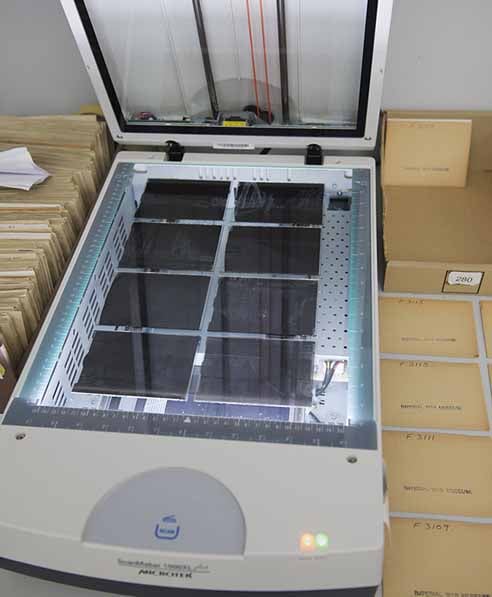
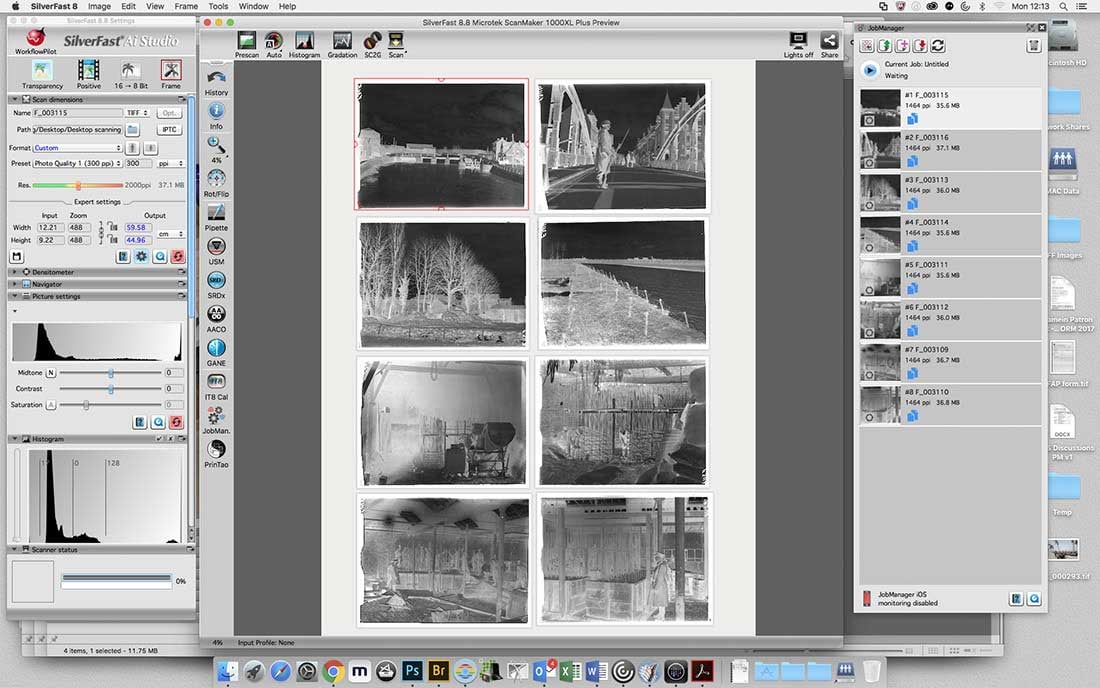
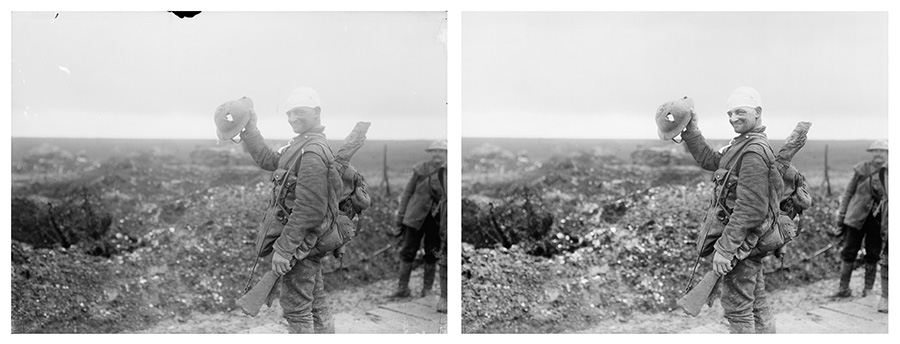

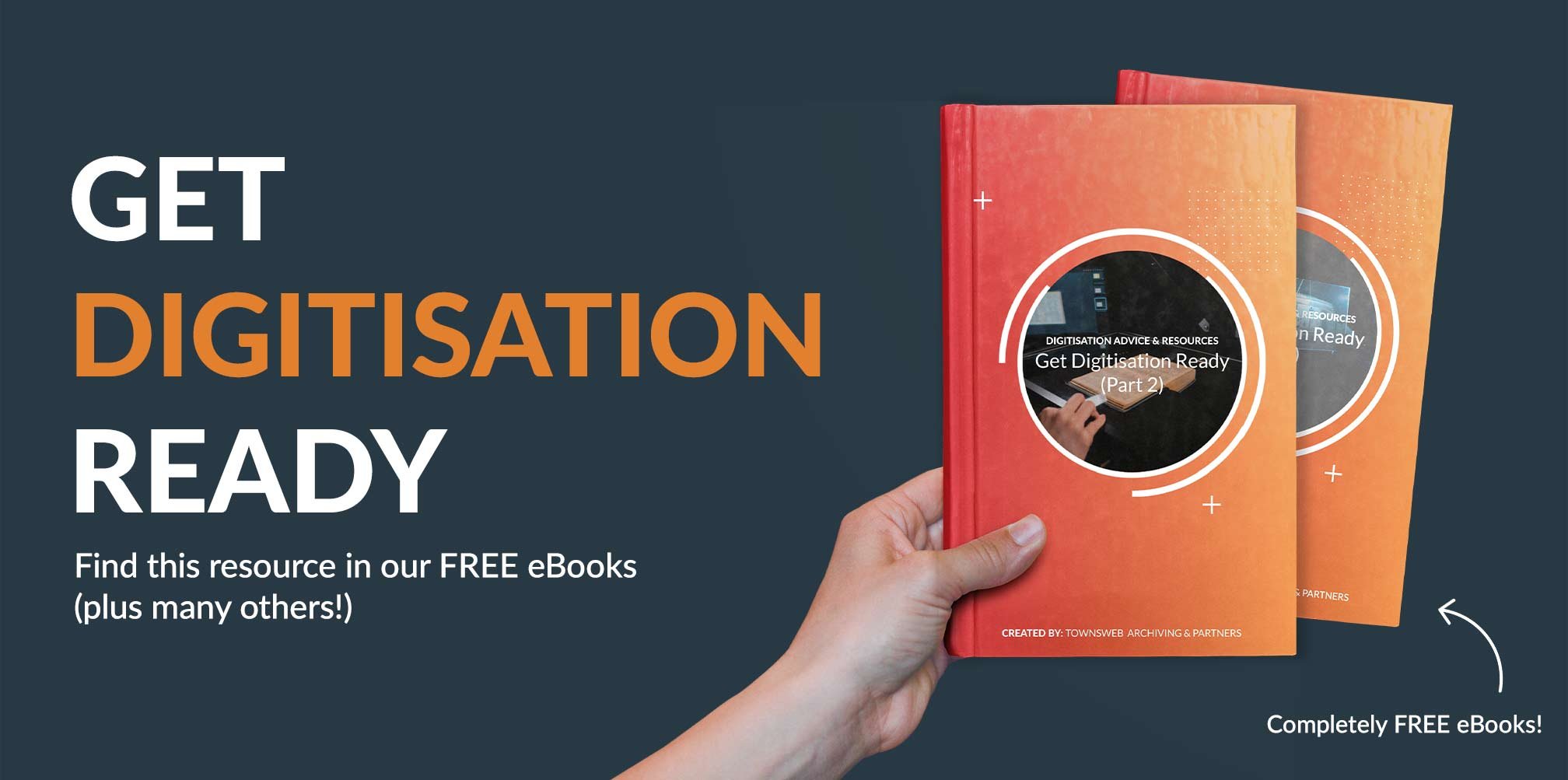
 USE OUR ONLINE
USE OUR ONLINE

